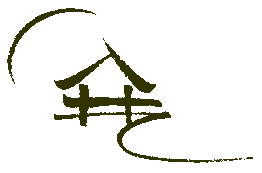
 |
The New Independent Home
by Michael Potts

from chapter 4 :
Home Energy System Overview |
 Renewable energy sources for a home power system can be photovoltaics, wind, water, biomass, or any of these in combination; the accompanying diagram starts after the source. Whatever our sources, there will be times when we will wish to disconnect them from the house's wiring, and the Safety Disconnect accomplishes this. The S-curved symbols represent fuses, which are the first line of overcurrent protection. When too much current flows through a fuse, it quickly heats up and "fuses" or melts, thereby breaking the electrical circuit. A fuse is a one-time device; once fused, it must be replaced.
Renewable energy sources for a home power system can be photovoltaics, wind, water, biomass, or any of these in combination; the accompanying diagram starts after the source. Whatever our sources, there will be times when we will wish to disconnect them from the house's wiring, and the Safety Disconnect accomplishes this. The S-curved symbols represent fuses, which are the first line of overcurrent protection. When too much current flows through a fuse, it quickly heats up and "fuses" or melts, thereby breaking the electrical circuit. A fuse is a one-time device; once fused, it must be replaced.
The Charge Controller controls the amount of electricity from the source that is applied to charging the battery bank, based on the batteries' state of charge. Each DC branch circuit is connected to the positive bus bar within the DC Load Center through a circuit breaker, which is an electrical analog of a fuse. When too much current flows through a circuit breaker, it "trips" and interrupts the circuit; when it has cooled down, and the overcurrent condition has been corrected, it may be reset by switching it off, then back on. These circuit breakers protect their low-voltage circuit from overcurrent -- a "short circuit" -- and allow a branch to be turned off for servicing. Two wires conduct electricity between any two components in the power system, because electricity only flows in circuits; imagine a stream of electrons flowing away from the minus side and toward the plus side. For safety, a redundant third wire connects all metal frames and boxes to each other and to a ground rod driven into the earth.
The batteries and instrumentation are the focus of a DC system, and safety is the guiding principle. Note that even the meter is fused.
The inverter changes low-voltage DC power into house current, 110-volt alternating current. In the system diagramed, the inverter includes a battery charger that can accept AC electricity from the generator; when the generator is providing power, the inverter uses electricity from the generator to recharge the batteries while protecting the DC system from irregularities in the generator's ac output.
The AC Load Center provides convenient connections and circuit-breaker overcurrent protection for ac circuits in the same manner as the DC load center.
|


|